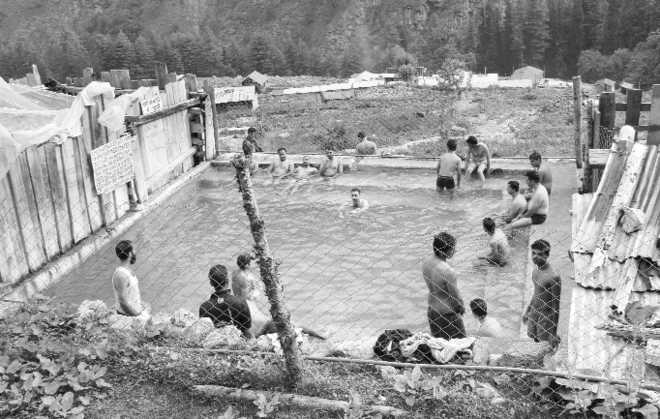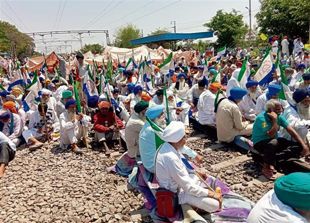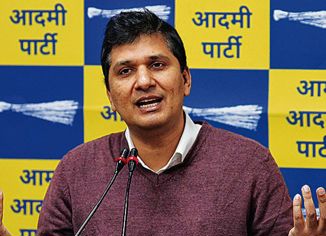
Liquid money: A hot spring at Kheer Ganga in Kullu. Photo: Jai Kumar
Kuldeep Chauhan in Shimla
Before you could consider winding down in a spa, here’s something to munch about: etymologically, you can give it to a Belgium town for enriching you with the word spa. Known as the Pearl of the Ardennes lying in the east of the country, Spa is known for its mineral-rich thermal waters. The eponymous town complements that country’s economy in millions of dollars for its therapeutic water-bottled or in natural surroundings. Take others: Japan takes the lead with 13,754 spa resorts while China has 3,100 (Tibet has 672). Europe accounts for over 19% of spa industry with Iceland becoming a true geothermal destination.
Back home, sigh! Himachal as well as J&K have plenty of such mineral-rich springs —from Kheer Ganga and Tattapani in Himachal Pradesh to Puga and Chuma Thang in Ladakh. Yet these hot bathing havens haven’t clicked with the state governments desperately trying to emerge from deep financial straits.
Vashisht in Manali, Kheer Ganga and Manikaran in Parbati valley in Kullu and Tattapani in Mandi and Jeori and Tapri in Kinnaur can be developed into popular spa destinations, which contribute to a $ 60.5-billion global tourist market. The hot springs can also generate green power worth 10,000 MW (countrywide) and can help in cold storage, thus empowering local village economy in an eco-friendly way.
Charles Davidson is chairman of Global Hot Springs Forum (GHSF), and has done research on hot baths in 21 countries. He inspected hot bath hubs in Himachal during his recent visit to the state. The GHSF has prepared a ‘global hot springs view dials’ connecting the hot springs and promoting wellness and spa tourism around the world. Indian hot-spring ‘view dial’ includes places in Himachal, Sikkim and some southern states, says Davidson.
“The hot bath springs in India have contents similar to Europe’s. As part of health tourism, these need a lot of investment. The best option can be the PPP mode in India as is the case in Europe, Japan, and China,” says Davidson.
Rural economy
Hot springs also promise a new hope for the Rs 4,000-crore apple industry. Indian Institute of Technology (IIT) Mandi is on its way to developing apple cold stores and fruit processing using this cheap geothermal sustainable source of energy.
IIT researcher Dr Vijay Chauhan says hot springs in Manikaran, can provide cold storage capacity of 1,000 tonnes and generate 30-KV of power. This power can be used to run a processing plant with a capacity of 30 tonnes. The Manikaran spas’ temperature ranges from 98 deg C to 91 deg C and flow at 7 litres per second. “We have combined two cycles of geothermal energy to get a cycle that can use this energy for cold storage and generate power through turbines,” he says.
The cold stores use no electricity and lower down on transportation cost. The farmers can store fruit locally, extending the processing period by over a month. On a ‘save-hot water springs mission’ in the western Himalayas, a team of scientists has inspected the Tatta Pani spring recently. The project team of a joint Indo-Norwegian venture has proposed that hot springs Tatta Pani, Manikaran, Vashisht and Puga and Chuma-Thang in Ladakh can be developed as geothermal tourist destinations.
Not beyond pilgrimage
Located around 3 km from Manali, Vashisht hot baths at 1990 m height are managed by a local temple committee and have not been developed beyond pilgrimage. These are Turkish-style baths with separate sections for men and women. “It is a miracle in a cold area. A dip takes away all your fatigue. We spent almost an hour, and didn’t feel like coming out,” says Pragya Jeevan, a tourist from Delhi.
The Kheer Ganga spas remain in mystery. You find only sadhus and few a hashish kick seekers in shacks and temple sarai. The hot springs ooze out along the Parbati at the foot of the Mantalai glacier at Kheer Ganga, located on an arduous 9-km trek from the Barshaini road head on the Kullu-Manikaran road. “A dip in the natural hot water spring in Kheerganga is a life-time experience,” says Karnik, a tourist.
And Manikaran has turned into an ugly concrete mess with a maze of concrete sarais, buildings, dhabas, shacks and guest houses. Traffic jams on the Kasol-Manikaran road in summer are a routine as the road is in a bad shape. “Nobody bothers to develop Manikaran as spa destination,” says Raghuraj Thakur, a local resident.



























